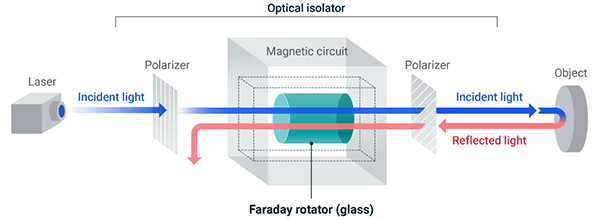Development of a Key Component for Laser Fusion – The Glass Faraday Element: A Crucial Innovation for Large High-Power Lasers –
(Laser Matter Interaction Science, Advanced Research Center for Beam Science, ICR)
Prof. TANAKA, K.
(Department of Material Chemistry, Graduate School of Engineering, Kyoto University)
Kyoto University, Nippon Electric Glass Co., Ltd., Institute of Laser Engineering at Osaka University, and National Institute of Fusion Science have developed “Glass Faraday Element” as key component of large high-power lasers. The optical isolator incorporating this component suppresses laser back reflection, a major issue in large high-power lasers. High-power lasers are expected to be applied in a variety of fields that require precision engineering and advanced laser control, such as laser fusion, the removal of space debris, and cancer therapy using heavy particle beams.

Left: Large high-power laser device “SENJU (Super-Energetic Joint Unit)” *Courtesy of: Institute of Laser Engineering at Osaka University,
Right: Developed glass-made faraday element 110×110mm
Institute of Laser Engineering at Osaka University is currently developing a large-scale high-power laser system called SENJU, which features a large beam diameter of Φ90mm. As a key component for controlling the beam, Glass Faraday Element that can be made large in size are considered promising.
Features of Glass Faraday Element
The Glass Faraday Element is an optical component used in optical isolators. It is a specialized element that rotates the polarization plane of light by utilizing a magnetic field. The newly developed glass-made Faraday device has the following features, surpassing conventional materials such as terbium gallium garnet (TGG).
Can be manufactured in larger sizes
It is 110✕110mm enough to control very large diameter beams (Φ90mm).
High-power resistance
With a lower absorption coefficient than TGG, it maintains optical quality even under high-power laser operation.

Schematic representation of an optical isolator and the Glass Faraday Element
Terminology
| Faraday element | One of the parts that control light, which uses the force of a magnet to rotate the angle of the polarization plane of light. |
| Optical isolator | In laser systems, it is essential to suppress unwanted reflected light. An optical isolator is an indispensable device for laser equipment to prevent damage to the light source and generation of noise because it passes forward light and blocks backward light. |
| Absorption coefficient | A parameter that quantifies how much light a material absorbs. Absorbing laser light generates birefringence (a phenomenon in which light is refracted in two different directions when it passes through a specific substance). It lowers the degree of polarization and leads to a decrease in the quality of the beam. |
| TGG | TGG (terbium gallium garnet) is a special crystalline material widely used in optical applications. Laser power resistance is high, but it is difficult to increase the size. |
| Laser Fusion | A technology that uses intense laser light to cause a fusion reaction. Nuclear fusion is a phenomenon in which a large amount of energy is released in the process in which light nuclei (usually isotopes such as deuterium and tritium) are bonded to form heavier nuclei. |
| SENJU | Abbreviation for high-power laser equipment, Super-Energetic Joint Unit, which is being developed by Institute of Laser Engineering at Osaka University and aims to achieve the world’s highest mean power. Conventional high-power lasers can fire lasers only once every few hours due to cooling-related technical issues, but SENJU is capable of firing 100 laser pulses per second by devising materials and cooling methods. |
| High power laser | Advanced combined light technology used in laser fusion, removal of space debris, and advanced medicine such as cancerous therapy with heavy particle beams. |
Background of joint development
Laser back reflection from high-power lasers poses a major challenge for the realization of the equipment, as it poses a risk of laser equipment damage and noise problems. Nippon Electric Glass has developed a glass-made Faraday element that meets the requirements for large, high-power lasers by leveraging its experience in developing compact optical isolators for high-power lasers. Kyoto University and the National Institute of Fusion Science are evaluating the glass. The Institute of Laser Engineering at Osaka University is implementing it as an optical isolator for the “SENJU”.
The Future of Laser Fusion and Energy Security
Laser fusion is attracting attention as a next-generation energy source with the aim of providing a stable energy supply and realizing carbon neutrality. With an energy self-sufficiency rate in Japan of approximately 13% (as of FY2021) *, laser fusion offers great potential for energy security.
*Source: PR pamphlet “Japan’s Energy 2023” published by Agency for National Resources and Energy, Ministry of Economy, Trade and Industry
Future prospects
We will continue prototyping glass with suitable size and thickness for laser fusion, while evaluating its optical properties and performance. We are advancing toward the commercialization of an optical isolator incorporating the Glass Faraday Element.
The Laboratory for Laser-Matter Interaction Science at the Institute for Chemical Research (Tokita Laboratory), Kyoto University, focuses on research in high-intensity laser science, including the generation, control, and application of high-power laser light. Specifically, our research focuses on developing high-power lasers, including mid-infrared systems, and investigating laser-plasma interactions, contributing to advancements in next-generation optical science and technology.
 Institute for Chemical Research, Kyoto University
Institute for Chemical Research, Kyoto University International Joint Usage Research Center
International Joint Usage Research Center